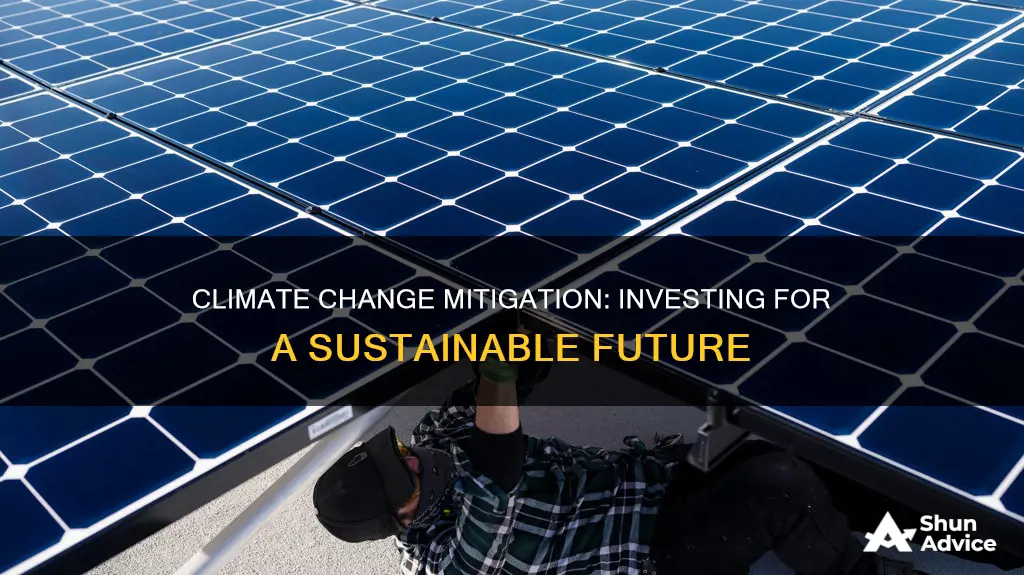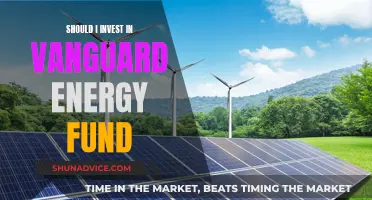
Climate change is an increasingly pressing issue, with global temperatures set to rise by at least 2 degrees Celsius by 2100 according to the UN's Intergovernmental Panel on Climate Change. The effects of climate change are already being felt, from rising sea levels to heatwaves and droughts, and it poses an existential threat to human society. As a result, investors are becoming more conscious of the potential impact on their portfolios and are seeking out more sustainable investment opportunities. Climate investments aim to support technologies and companies that will facilitate the transition away from fossil fuels and carbon-intensive industries. These investments tend to fall within the category of environmental, social, and governance (ESG) investing, which seeks to generate positive social benefits alongside profits. Examples of climate investments include alternative energy sources such as solar and wind power, green initiatives like carbon offsets and electric vehicles, and companies embracing the energy transition. While climate investments have traditionally offered lower returns, this gap is closing, and they may offer high returns in the future.
| Characteristics | Values |
|---|---|
| Investment type | Green technology, renewable energy, green initiatives, alternative energy, alternative transportation |
| Investment opportunities | Companies that can help mitigate greenhouse gas emissions or aid adaptation to a warmer world |
| Investment vehicles | Low-carbon mutual funds, exchange-traded funds, managed funds, automated investment platforms |
| Investment sectors | Energy, mining, construction, infrastructure, agriculture, water security, waste management, transportation |
| Investment trends | Renewable energy, green initiatives, nuclear energy, electric vehicles, battery storage, hydrogen power, carbon-capture utilization and storage |
| Investment risks | Physical damage to buildings, disruption to business and supply chains, stranded assets, environmental public relations crisis, natural resource shortages |
| Investment locations | Developing countries, East Asia, Pacific, North America, Western Europe |
What You'll Learn

Renewable energy sources such as solar, wind, and hydroelectric power
Investing in renewable energy sources such as solar, wind, and hydroelectric power is a crucial strategy to mitigate climate change. Here are some detailed insights into why and how to invest in these areas:
Solar Power
Solar technology is an up-and-coming area in the renewable energy sector. Investing in solar energy can be done by purchasing stocks in solar panel manufacturers or investing in managed funds such as the Market Vectors Solar Energy ETF (KWT) and the Guggenheim Solar Fund (TAN). These funds are globally diversified and managed by financial institutions like BlackRock and Fidelity.
Wind Power
Wind energy has experienced remarkable growth and cost improvements, with prices declining rapidly. According to the investment firm Lazard, the cost of generating electricity from wind has declined by 58% since 2009. This trend is expected to continue, making wind power an increasingly attractive investment option.
Hydroelectric Power
Hydroelectric power is another renewable energy source that utilizes the power of water to generate electricity. Investing in this area can be done through funds focused on renewable energy sectors or by investing directly in companies specializing in hydroelectric power technologies.
Benefits of Investing in Renewable Energy
- Addressing Climate Change: Renewable energy sources emit little to no greenhouse gases, helping to reduce the impact of climate change.
- Cost-Effectiveness: Renewable energy sources are often cheaper than fossil fuels, and their prices are dropping rapidly, making them an economically attractive option.
- Health Benefits: By reducing air pollution, renewable energy sources can provide significant health benefits, improving air quality and reducing health issues associated with pollution.
- Job Creation: Investing in renewable energy creates three times more jobs than investing in the fossil fuel industry, contributing to economic growth and social development.
- Energy Independence: Investing in renewable energy sources can reduce dependence on fossil fuel imports, providing energy security and protecting countries from unpredictable price swings.
- Long-Term Returns: While renewable energy investments may take years to pay off, they offer long-term returns and contribute to a more sustainable future.
In conclusion, investing in renewable energy sources such as solar, wind, and hydroelectric power is a crucial strategy to mitigate climate change. It offers both environmental and economic benefits, creating a more sustainable and prosperous future for all.
UK Pension Funds: Where Is Your Money Invested?
You may want to see also

Electric vehicles and alternative transportation
Electric Vehicles
The shift towards electric vehicles (EVs) is a crucial step in reducing emissions from the transportation sector. EVs have lower emissions over their lifetime compared to conventional internal combustion engine vehicles, especially in regions with decarbonised electricity generation. However, it is important to note that EVs still rely on electricity produced from fossil fuels in many parts of the world, and the manufacturing process, particularly battery production, can also contribute to emissions.
Alternative Transportation
In addition to EVs, there are other alternative transportation methods that can help mitigate climate change. These include:
- Shared mobility services such as ride-sharing and car-pooling, which can reduce the number of vehicles on the road and decrease emissions.
- Telecommuting and video conferencing, which reduce the need for commuting and associated emissions.
- Public transit-friendly cities with efficient city planning and land use that discourages the use of personal cars.
- Micro-mobility options such as scooters, bikes, and electric buses, which provide emission-free alternatives for shorter distances.
Policy Support
Strong regulatory policies and incentives have played a significant role in encouraging the adoption of EVs and alternative transportation methods. Examples include California's Zero Emission Vehicle regulation, the European Union's CO2 emissions standards, and China's New Energy Vehicle policy.
Investment Opportunities
The transition to electric vehicles and alternative transportation offers several investment opportunities, including:
- Investing in companies that produce electric vehicles and related technologies.
- Supporting the development and adoption of shared mobility services and platforms.
- Investing in companies that promote telecommuting and video conferencing technologies.
- Backing initiatives for efficient city planning and public transit improvements.
- Funding the development and manufacturing of micro-mobility options, such as electric scooters and bikes.
The Best Time to Invest in Funds: Morning or Evening?
You may want to see also

Green initiatives like carbon offsets and pollution control
Carbon offsets are a type of accounting mechanism that allows entities to balance their carbon emissions by investing in projects that reduce or remove carbon dioxide from the atmosphere. This can involve supporting renewable energy projects, clean cooking initiatives, or ecosystem restoration efforts. While carbon offsets have been criticised for their limited impact and potential greenwashing, they can provide flexibility for companies and individuals looking to reduce their carbon footprint.
When done right, carbon offsets can have several benefits. They can help channel funds to climate mitigation and conservation projects, particularly in developing countries. Offsets also allow entities to compensate for emissions that are difficult to eliminate, such as those associated with air travel. Additionally, carbon offsets can facilitate the transition to cleaner technologies and support communities and local economies.
To ensure the effectiveness of carbon offsets, several key principles should be followed:
- Additionality: Carbon offsets should lead to emission reductions that go beyond what would have occurred without the offset project.
- Permanence: Emission reductions or removals must be long-lasting, ideally lasting for at least 100 years, to have a meaningful impact on climate change.
- Leakage: Projects should address the risk of carbon-emitting activities simply shifting to another area or sector.
- Safeguards: Strong safeguards are necessary to protect biodiversity, ensure Indigenous and community participation, and prevent negative social and environmental impacts.
Another important aspect of green initiatives is pollution control. This involves implementing measures to reduce or eliminate the release of pollutants into the environment. Examples include investing in technologies that minimise pollution, such as electric vehicles or improved industrial processes, and supporting the development and adoption of cleaner and more sustainable practices across industries.
Overall, green initiatives like carbon offsets and pollution control play a crucial role in mitigating climate change. By following best practices and addressing potential challenges, these initiatives can contribute to global efforts to reduce greenhouse gas emissions and promote a more sustainable future.
Gilt Funds: When to Invest for Maximum Returns
You may want to see also

Energy-efficient buildings and infrastructure
Upgrading energy efficiency in buildings can lower energy costs for consumers, encourage job growth, and improve public health by reducing energy-related pollution. This can be achieved through improvements in HVAC standards, better insulation, and the adoption of energy-efficient technologies such as heat pumps, LED lighting, and efficient appliances. These upgrades not only reduce energy consumption but also lower energy bills, making them particularly beneficial for low-income households and underserved communities that often bear a disproportionate energy burden.
To accelerate the transition to energy-efficient buildings, stronger policy support is necessary. This includes implementing minimum performance standards, building energy codes, and incentives such as tax credits for energy-efficient upgrades. For example, the United States' Inflation Reduction Act of 2022 introduced tax credits for home energy assessments, insulation, and the installation of heat pumps. Additionally, venture capital investment in clean energy start-ups developing building technologies has been increasing, providing support for entrepreneurs and innovation in this space.
Furthermore, energy-efficient buildings are better equipped to transition to renewable energy sources, contributing to the global shift away from fossil fuels. By investing in energy-efficient buildings and infrastructure, we can not only mitigate climate change but also create a more resilient, equitable, and prosperous future for communities worldwide.
Banks' Investment Strategies: Where Do They Invest Deposits?
You may want to see also

Sustainable agriculture and water security
Sustainable Agriculture
- Crop diversification: Encouraging farmers to grow a variety of crops can improve soil health, reduce the need for chemical fertilizers and pesticides, and decrease the potential for water contamination.
- Contour farming and cover cropping: These practices help prevent soil erosion and runoff, which can carry pollutants into water bodies.
- Organic farming: This method relies on natural means to enrich soil and control pests, avoiding synthetic pesticides and fertilizers, further reducing water contamination.
- Precision agriculture (PA): PA optimizes production through efficient resource use, with soil fertility being crucial for nutrient supply. Recent innovations include a rapid, user-friendly, paper-based platform for determining essential macronutrients in the soil.
- Nanotechnology: Nanomaterials can be used to enhance seed viability, disease resistance, nutrient uptake, germination, and seed quality. Nanosensors and nanobiosensors can monitor and manage crop health, water usage, and soil quality. Nano-enabled delivery systems can also precisely apply fertilizers, pesticides, and growth regulators, minimizing waste.
- Biofertilizers: Microbial cultures such as plant growth-promoting rhizobacteria, Azotobacter, Mycorrhizae, and blue-green algae can increase crop yield and are eco-friendly. They help with N-fixation, phosphate solubilization, root growth promotion, organic matter decomposition, soil fertility enhancement, and mineralization.
Water Security
- Nature-based solutions (NBS): NBS use natural processes to address socio-environmental challenges. This includes managing vegetation, soils, and wetlands to enhance water quality and availability. Constructed wetlands, for example, act as natural biofilters, trapping pollutants like nitrates, phosphates, and sediments from agricultural runoff.
- Buffer strips or riparian zones: Vegetated areas along water bodies help filter out pollutants from agricultural runoff and enhance landscape connectivity, providing habitats for various species.
- Agroforestry: Combining trees with crops or livestock improves soil fertility, increases biodiversity, sequesters carbon, and provides alternative income streams for farmers. Trees act as filters, absorbing excess nutrients and pollutants, and help reduce soil erosion.
- Water infrastructure: This can include the development and maintenance of dams, canals, and reliable water supply systems to prevent flooding and ensure access to clean water.
- Early warning systems: With climate disasters increasing, investing in early warning systems can save lives and reduce damage. The UN's 'Early Warnings for All' initiative aims to spend $3.1 billion from 2023 to 2027 to achieve universal coverage of early warning systems.
Mutual Fund Investing: What You Need to Know
You may want to see also
Frequently asked questions
Climate investing refers to investing in technologies or companies that are likely to become important as the world transitions to less carbon-intensive energy sources and moves away from fossil fuels.
Climate change poses several risks for investors, including physical damage to buildings and infrastructure, disruption to businesses and supply chains, and pressure on natural resources.
Sectors such as renewable energy, electric vehicles, battery storage, hydrogen power, and carbon capture offer opportunities for investors looking to mitigate climate change.
Investors can consider a company's environmental and social priorities, including climate disclosures, carbon footprint, natural resource use, waste management practices, and board diversity.
Yes, there are several funds focused on climate change, including the Green Climate Fund (GCF) and the Climate Investment Funds (CIF). These funds provide financing and expertise to developing countries to support their transition to a more sustainable future.







